
drawing, graphite
#
drawing
#
mannerism
#
figuration
#
form
#
vanitas
#
line
#
graphite
#
realism
Dimensions: 205 mm (height) x 170 mm (width) (bladmaal)
Curator: Here we have "Skull," a graphite drawing created by Giovanni Battista Caracciolo sometime between 1578 and 1634. It resides here at the SMK, the Statens Museum for Kunst. Editor: The drawing is surprisingly delicate. Even though it depicts death, it isn't gruesome. There is a softness in the rendering that captures form using very controlled linear strokes, almost mathematically so. Curator: Skulls, especially during the late Renaissance, were frequently employed as *vanitas* symbols reminding viewers about the fleeting nature of life. It also emerged as a symbol for understanding a moment where many forms of knowledge and being meet their limits. Editor: True. You can see how Caracciolo emphasizes structure. He uses line and form so exquisitely, achieving a rounded depth with something as simple as hatching. Notice how each mark helps to shape its dimensions and spatial relationships. Curator: Within its historical moment, its stark presentation spoke to mortality at a time when Europe experienced wars, plagues, religious conflict, colonialism, all things that disrupted notions of being, forcing reflections about how societies relate to death and dying. Editor: And the neutrality in expression feels very studied, more of a conceptual rendering. The artist has managed to distill the human form down to line. I am curious about the composition. It has a slightly off-center placement with very simple crosshatching as the setting; what do you make of that? Curator: I interpret the framing and shadowing as the quiet aftermath, that moment after everything has faded, calling into question what truths endure beyond this earthly reality and its emphasis on the material and ephemeral. Editor: I now view it differently. Considering our discussion and reflecting on the construction of space, perhaps this simplicity is an argument for truth itself? Curator: Yes! "Skull" prompts essential inquiries that concern not just art but broader conditions of being—the intersections of our material world with historical memory, meaning-making, and life’s inevitable end.
Comments
No comments
Be the first to comment and join the conversation on the ultimate creative platform.














